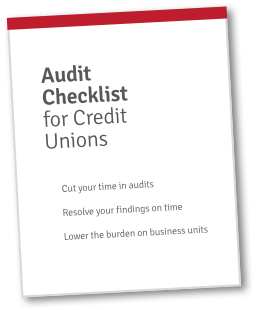There’s this old joke in accounting that starts off like, “knock knock.”
And then, “who’s there?”
“The auditor.”
But there’s almost never a good punchline, because audits aren’t funny.
Maybe you’re a little better prepared. After all, you’re not just any business. You’re a credit union. You’ve been dealing with audits and regulatory boards since forever, so you probably have some idea of what to expect, and on what timeline.
Know What to Expect, Really
Although this may not be your first rodeo, things change from year to year. Often, in the financial industry, things change from month to month. Just because your team nailed it last time doesn’t mean you’ve got it dialed.It’s always important to carefully review the letter detailing exactly what’s required in the internal audit. You’ll need to identify any familiar questions, as well as any new information, and you may want to speak with the auditor to clarify things. Understanding the full scope of the audit will keep you from scrambling during the examination.
Mobilize Your Staff
The internal audit may require the expertise of several people within your organization. You’ll need to mobilize key staff members or departments. Let them know what data they’ll need to submit, to whom, and by when.It helps to establish clear lines of communication between everyone involved in the audit. Nobody wants to do work that’s already been done. Also, it’s important that everyone stay on the same page—otherwise, some items may go unaddressed, such as when two parties each assume the other is responsible.
If you need to involve inside or outside counsel, now is the time to bring them in as well.
Collecting Documents
Ideally, your credit union has a secure, reliable filing system. There are few things in life more frustrating than looking for something that you know you have, but being unable to find it. If your credit union has well-managed documentation and archives, finding what the auditors request will be a cinch.Unfortunately, file management is one of the first casualties of someone in a hurry. Sometimes new employees don’t understand the intricacies of your system. On rare occasions, the IT department will upgrade servers and change pathways ever so slightly.
Maintaining consistent file and information structure in your credit union will help during daily operations. During an audit, that consistency will make it that much easier to quickly identify and file the documents you need.
Paper Trail
Speaking of consistency, a robust paper trail helps all parties involved. Your auditor may want to see past reports and documentation in addition to the current information.If a credit union can quickly provide a strong history of compliance and consistent responses, they’ll be less likely to receive further scrutiny, costly follow-up requests, or regulatory action.

FREE: Audit Checklist for Credit Unions
4 key principles and 9 questions to jumpstart your audit planning. From leading credit unions.Get Ready To Deliver
Hitting deadlines is imperative. Doubly so in the auditing world. You may be ready for your internal audit, but are you ready to deliver it?After you’ve put together your team, collected the requisite information, and compiled all necessary documents, it’s time to turn them over. Using email or another unsecure service work fine, but may open further systems to legal discovery.
To explore how Redboard may be able to help your credit union better prepare for and submit examination materials from all involved parties, visit the following links:
Managing Risk for Credit Unions
Getting Your Credit Union Organized for an Audit or Exam






